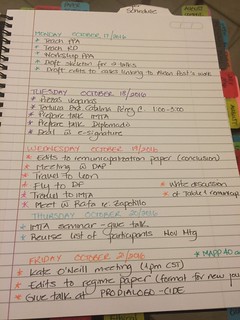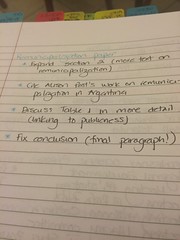One of the things I’m an expert on is overwhelming myself with the sheer amount of work I have to do. In the past decade, I have slowly become better at simply reducing the size of my To-Do list and breaking down my workload into manageable tasks, at focusing on just one thing at a time, at ensuring that I have a Completed Tasks list (what Dr. Katherine Firth calls, “the Done List”), at building flexibility into my calendar and inserting buffers into my daily activity and not assuming that I can finish everything on the same day, and that I can knock a few Quick Wins off my To-Do list every single day.
The Rule of Threes – a great way to convert the overwhelming to the manageable and bust stress. #planning https://t.co/AmQDC9OtvV
— Kate Foy (@Dramagirl) January 19, 2017
The way in which I try to tackle my ever-growing to-do list is to use a method that I call “granular planning and the Rule of Three“. Granular planning refers to breaking down the work in accomplishable tasks, and then scheduling them throughout the week/month.
#acwri @raulpacheco just mentioned 'granular planning' So crucial: committing to the small daily tasks that will comprise the ultimate goal.
— ExplorationsofStyle (@explorstyle) June 11, 2015
It’s granular because it is refined at the micro-scale, as opposed to grand-vision planning at the macro-scale. I adopted this method of granular planning from my Masters’ degree courses on Project Management (I took several courses in the Civil Engineering department at UBC, and my brother is a civil engineer and an expert on project management — by the way, you can read and buy his book here).
The Rule of Three is quite simple, as Professor Stephanie Wheatley mentions in her tweet below.
Every day, I make a list of 3 things I need to get done. Just three–not always academic. It makes things more manageable. #withaphd
— Stephanie Wheatley (@Whtmstr13) October 17, 2016
I list 3 things I need to accomplish every day (which is a very sensible approach), and I also break down each paper revision or piece of research into 3 components (hence The Rule of Three). If the list of components I need to fix (or research or write) is much longer than 3 items, then we have a bit of a problem, but as long as it’s just 3-5 things, I can deal with it.
Granular planning and The Rule of Three https://t.co/Ic8W3V2M5d Break down projects in thirds, schedule 3 things per day, buffer 3x the time
— Dr Raul Pacheco-Vega (@raulpacheco) December 30, 2016
Then I insert one item per day (or two, if I have a particularly lax day where I can just write or do research). This is important, because I need to know that when I budget time for a specific task, I can actually accomplish it on that day. If I can’t, for some reason, I migrate the task to the following day.
 As an example, you can see my To-Do list for this week (my Weekly Plan, as written in my Everything Notebook). This plan is mirrored both in my Google Calendar (particularly talks I need to give, and meetings I’m supposed to be attending), and my Weekly Activity Whiteboard (you may have seen those in this post). As you can see, I have two days off campus this week (I’m giving a talk on Thursday at the Mexican Institute of Water Technology, and a guest lecture on Friday with the PRODIALOGO-CIDE programme). This means I need to plan my travel accordingly. I also have four meetings (one with students, one with my PhD student, one with my colleagues on campus, and one with my coauthor Dr. Kate O’Neill), and one event (the 40th anniversary of our Masters programme) to attend. But I also want to finish a paper on remunicipalization that I have almost ready, and that I know I basically can finish this week because the changes are pretty minor.
As an example, you can see my To-Do list for this week (my Weekly Plan, as written in my Everything Notebook). This plan is mirrored both in my Google Calendar (particularly talks I need to give, and meetings I’m supposed to be attending), and my Weekly Activity Whiteboard (you may have seen those in this post). As you can see, I have two days off campus this week (I’m giving a talk on Thursday at the Mexican Institute of Water Technology, and a guest lecture on Friday with the PRODIALOGO-CIDE programme). This means I need to plan my travel accordingly. I also have four meetings (one with students, one with my PhD student, one with my colleagues on campus, and one with my coauthor Dr. Kate O’Neill), and one event (the 40th anniversary of our Masters programme) to attend. But I also want to finish a paper on remunicipalization that I have almost ready, and that I know I basically can finish this week because the changes are pretty minor.
 As you can see, I broke down the edits I need to make to the paper into four different pieces of work. This is important, because writing on my To Do list “I have to finish the remunicipalization paper” doesn’t help. What tasks do I actually, honestly, clearly need to finish? I re-read my paper, and found the four spots where I can see the document is still weak. So I planned to finish those four tasks (do note that here, I am breaking The Rule of Three and actually making four edits, but that’s beside the point). I broke down the work of editing a paper for final submission into a set of four manageable tasks. That’s granular planning, combined with the Rule of Three (again, in this particular case, the rule of four). You can see, for example, that one of my four items is editing a concluding paragraph. I can do that in 2 hours!
As you can see, I broke down the edits I need to make to the paper into four different pieces of work. This is important, because writing on my To Do list “I have to finish the remunicipalization paper” doesn’t help. What tasks do I actually, honestly, clearly need to finish? I re-read my paper, and found the four spots where I can see the document is still weak. So I planned to finish those four tasks (do note that here, I am breaking The Rule of Three and actually making four edits, but that’s beside the point). I broke down the work of editing a paper for final submission into a set of four manageable tasks. That’s granular planning, combined with the Rule of Three (again, in this particular case, the rule of four). You can see, for example, that one of my four items is editing a concluding paragraph. I can do that in 2 hours!
The important thing about granular planning is deciding the size of the three tasks. For me, a task is manageable, it’s of decent size and it will make me feel like I accomplished something. One of the great things about granular planning and the Rule of Three is that you can break down any task into three pieces of work and then apply the method to any process. A few examples:
- If you need to revise a manuscript, you can plan the 3 items you are going to work on and place them in the Drafts Review Matrix.
- You can make your 3 items, your Quick Wins for the day.
- You can decide you don’t have full days to work on each piece, and that you are going to devote just 30 minutes to one of the three tasks.
- You can plan to dump 3 papers (one each day) into your Excel literature review worksheet.
- You can schedule time to write one memo per day, each memo being related to each other.
- Instead of overwhelming yourself with “I need to Read All The Things by next week“, you can plan to read one paper per day, and thus by the time you’re done, you’ve read 3 papers in one week, and possibly written a memorandum about each one.
The last thing that I actually didn’t discuss very clearly on this post was “budgeting 3 times what you had originally planned to take in doing the thing“. I’ve written before on how you need to build time buffers to ensure that you complete things on time. With the Rule of Threes, what you have to do is assume that finishing the project or component may take you up to three times as much time as you had originally planned to take. Creating buffers this way allows you to avoid feeling overwhelmed by the sheer amount of work that you need to do in such a short period of time.
@raulpacheco finishing a manuscript takes longer than writing the thing to begin with. It's one of the universe's charming little jokes.
— Ayelet H Lushkov (@Dr_AHL) October 27, 2016
So again, to recap:
- Break down every project (or project component) into thirds, and schedule those thirds throughout the week.
- Create a To-Do list with AT MOST three items you want to accomplish during the day. Schedule them throughout the week, using the previously broken down components.
- Budget enough time to finish the project, with an allocation of up to 3 times as much time you had planned to take in the first place.
A very close friend of mine, and colleague, has already implemented this Granular Planning and Rule of Threes method and it’s been working for her. It works for me, and hopefully it will work for my blog readers!

0 Responses
Stay in touch with the conversation, subscribe to the RSS feed for comments on this post.